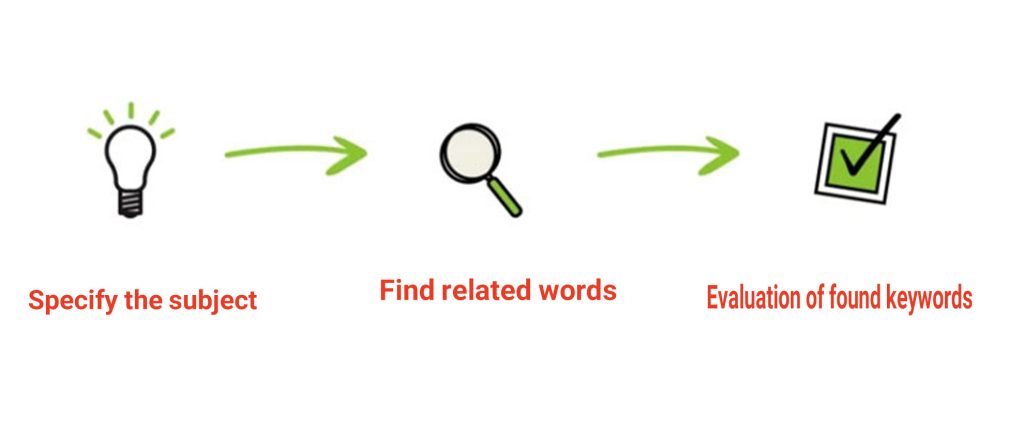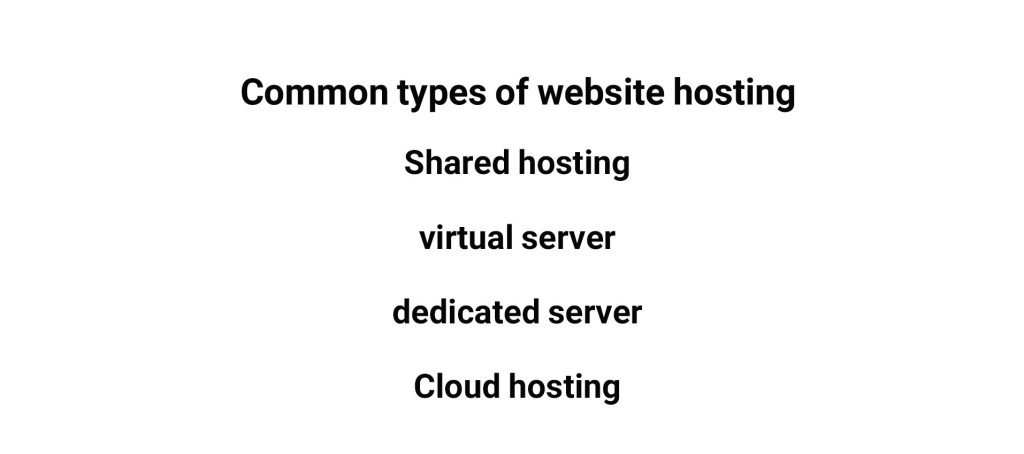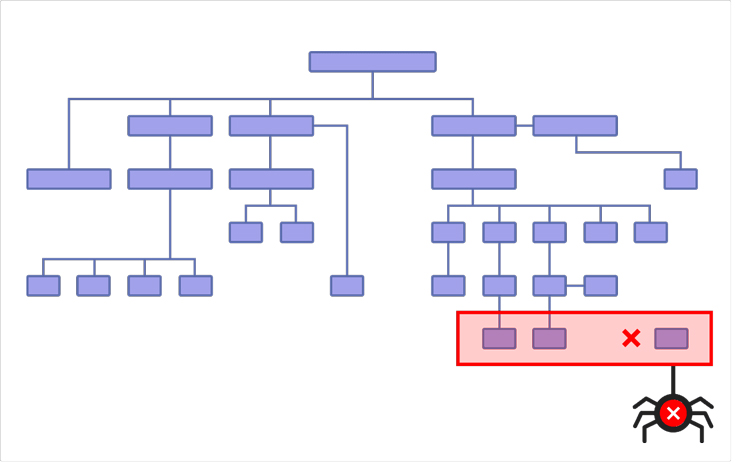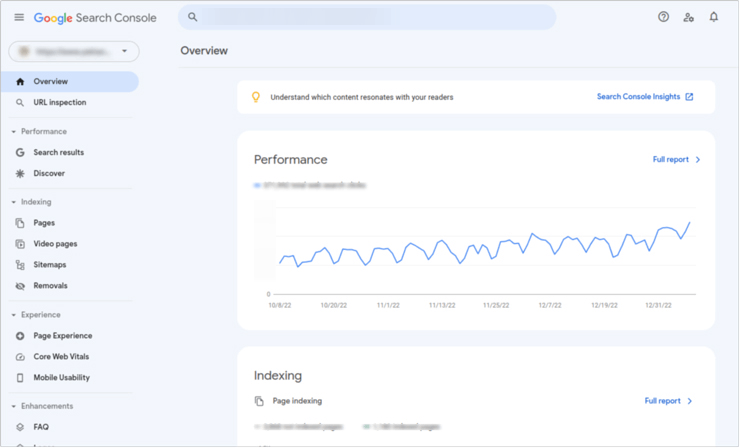Be patient! Patience is necessary in all stages of life and even when you are looking to improve your Google ranking!
Along with patience, you should take a series of actions that we will examine in this article in 8 sections. The tips we share with you are useful for both those who have a website and those who want to create their own website. So stay tuned to Hinet.
Step Zero: Do your research before you start
No two sites can use the same SEO strategy! Because each site has its own characteristics and needs. For this reason, before doing anything to improve your site’s ranking, you must gather complete information in various fields.
Find valuable keywords
- Valuable keywords (words that are profitable for you, i.e. the ones that bring you the highest quality and most potential customers)
- User needs (did you correctly identify the user’s need?)
It is very important to separate the words that are worth investing in from the rest of the words in the keyword research process; In fact, all your efforts should revolve around these precious words.
Usually, the words that are searched for the purpose of buying have more value; But not always and not for every site!

Identify customer needs
Another important issue is knowing the needs of your target market. Your product or service must solve a problem of the audience, otherwise it will not be of value to them!
As we said, you need to find suitable and valuable keywords with keyword research. In the continuation of the same process, it is necessary to identify the user’s need for each search. Usually, the purpose of people searching is one of the following 4 things:
- Finding the address of a site or a location (Navigational)
- Obtaining information about a specific subject (Information)
- Buying a product or service (Transactions)
- Research
When you know what the user’s goal is for searching for each term, you can generate the right content for the chosen keyword. Sometimes, during keyword research, you realize that you didn’t correctly identify the audience’s need or that this need has changed over time.
For example, at a time when Instagram Rails was not released for Android phones, the main and dominant need was nothing other than teaching how to publish Rails with these phones; That is, how to bypass this limitation. However, that need is now gone! Now people need more to get to know the same features and facilities of Rails and not the ways to bypass the limitations.
Competitor analysis
The last part of the research phase with the aim of improving the Google ranking is related to the detailed examination of competitors and finding their weaknesses and strengths.
- What words are they focused on?
- Do they have a strong blog?
- Is there a topic that is hidden from the eyes of competitors and you can attract traffic by focusing on it?
- What’s going on in the competitors’ comments?
- How do you rank against them in valuable keywords?
- What made them rank better for your valuable and targeted keywords?
- How many backlinks do you have and at what level are they?
In general, the more information you have about your competitors, the better you can adjust your strategy and the more effective your actions will be.
Well, research was the zero step in improving the Google ranking. Now we just want to get into the main story.
Step 1: Determine or rebuild the site structure
Even if you have a unique strategy and do all the necessary actions to improve SEO in the best way, if you don’t have a proper structure for the site, you will fail! Having a proper structure both satisfies Google and makes the user enjoy spending time on the site; In other words, have a good user experience.
When the site has a proper structure, Google crawlers will index the site more easily and understand its content better.
Creating the required pages
In the first step, you need to create the pages you need for the site. Site SEO is not just about ranking for the home page or blogs! You cannot always respond to the needs of the audience with an educational content; As you saw in the previous section, behind every phrase is a purpose and need.
For example, stores need product and category pages in addition to their main and magazine pages. The category page can be made based on brand, product type or…
Pages such as rules, contact us and about us may not be directly in the SEO program; But they are necessary to create a good user experience and arrange a suitable structure.
Prioritize pages
According to the goal you have in mind, you should prioritize the pages; Google also needs to understand which pages are more valuable to you. For example, consider the pages of a store website:
- main page
- Category page
- Product page
- Blog article
- The main page of the blog
- Other pages (rules, about us, etc.)
The category page is the first priority; Because usually when buying, customers like to see the product group. After that, the product page takes priority, followed by blog articles.
The main page is our fourth priority for remembering the brand name, followed by the other pages we mentioned.
This prioritization is also used for link building with the aim of improving Google ranking; Because you know which page is more valuable and should get more links.
Internal linking
So far, we talked about the structure of the site, the required pages and also the prioritization; But how to connect the pages to each other? With the link!
Links are important for improving Google ranking in two ways:
- They direct users to different sections (they need).
- Google gives more importance to pages that have more links
Once you’ve prioritized the pages, it’s time to link to them. 60-70% of the traffic of sites that work on content marketing is from Google, which should be redirected to other pages.
Most of the time, it is the input from the blog site that should be directed to the product category, product page or other posts.
For example, we may direct you to the “Click Ads” page to select the required service or send you directly to one of the services such as “Matched Ads”.
Just note that the destination link must match the user’s needs. For example, in a content with the topic “The best free digital marketing course, from click ads and content marketing to SEO and Google Ads”, we cannot ask the user to register in the hinet panel.
Apart from the backlink that we talk about earlier, the number of links you give to a page has a direct role in improving its Google ranking; Because that means it is more important!
To improve your ranking, it is better to work on linking related articles to each other as well as articles to services and products. On the other hand, find and correct broken links so as not to harm the user experience.
If you have already done these things, it might not be a bad idea to re-check each of them so that by fixing possible errors, the site is ready to reach the top results of Google.
The next part is related to checking the technical aspects of the site.
Second step: deal with technical issues
Technical SEO alone is a detailed topic that we have already discussed in full in the article “What is Technical SEO (Getting to Know the Basics of Technical SEO)”. Here are some things to improve your ranking:
First of all, make sure your site has a good host. In many cases, inappropriate hosting prevents you from achieving top rankings in Google. You can use the help of an expert to ensure that the website hosting is good.
Maybe it’s better to go for a dedicated one instead of shared hosting depending on your needs; Because in shared hosting like an apartment, all the resources are divided between the units and one of them may be more consuming than the others.

Your hosting and server should not be such that it cannot host a large number of visitors! Any small error, such as not connecting to the server, can cost the user a loss; Because not everyone can refresh the site and return to the results page.
Besides the common server errors, the slowness of the site due to high traffic is also important, which again ends in a bad user experience. If you have not chosen a suitable host, change it as soon as possible
Another important issue related to technical issues is the optimization of site codes; Because they play a big role in site speed. Reduce the size of the codes and make sure there is no suspicious item between the codes!
The third thing is that your site must be made for mobile. Make sure your site is displayed well on smartphones; Both in terms of appearance and speed.
Fourth, make sure your site is crawled by Google. For example, check the robots.txt file and see if you have intentionally or unintentionally restricted the movement of robots or not!
Among other things, we can mention duplicate pages, unnecessary and boring redirects, broken (broken) links. You may even remove the page from the search results yourself with the noindex tag.
Another task that is important in building links and arranging the structure of the site is to find orphan pages; Pages that are not linked to. Neither the user nor the Google bots will find it and you will be in trouble.
If you look at the image below, you can see that the Google bot will not find the last page. On the other hand, this structure is really messy and not suitable for the site.

Using CDN as well as not uploading large files (compressing files) is another way to increase the site in Google.
Now you need to produce good content!
The third stage: it’s time to produce and optimize the content
A site without content is like a plate without food! It can be said that it has no value 🙁 Producing valuable and user-friendly content is one of the ranking factors of Google; So let’s check the important and effective things in improving Google ranking together:
Creating content for profitable keywords
Above, in the keyword research section, we said that you need to identify valuable keywords. Assuming you did, now is the time to create content for those profitable keywords.
Let us give an example about ourselves so that the discussion of profitability will fit for you. We can increase blog traffic by creating content about superficial topics or things like “30 love texts for Instagram”; But it is of no use to us.
Why? Because first of all, our goal of content marketing is to attract potential customers and not traffic! Second, we want to show our expertise and gain a certain position in the market.
Therefore, spend time and money on creating content that will bring you and attract potential customers.
Tip: Without keyword research, creating content is like pounding water in a mortar! When creating content, make sure that the content is consistent with the user’s search intent.
For example, a user who searches for the phrase “buying a sleeping bag” is not looking for a detailed article about the types of sleeping bags! He simply wants to enter a product page and finalize his purchase; So if one of your keywords is to buy a sleeping bag, it is better to optimize the sleeping bag category page for it.
To understand the user’s search intent, you can manually search for the same phrase in Google; See what the results answer, most of the time, the user’s search intent is what the current results show. Of course, you may find that the results have changed in subsequent audits, so you should correct and update the content.
Update content
Updating old content is one of the tasks that Google likes very much.
For example, if you have written an article about camping costs and the prices are from the previous year, we recommend that you update the article with the latest prices.
Of course, for time-sensitive articles, you should take Google’s recency algorithm very seriously. For example, news sites are ranked when their content is the most recent.
When you need to update content:
- The content is incomplete (after some time, by measuring your performance with the help of Google Analytics and Search Console, you realize that the content you wrote does not meet the user’s needs)
- Ask questions and get common feedback (for example, many users asked us to teach research in a practical way in the “Keyword Research” article).
- Changes that occur (for example, Instagram’s algorithm updates and you have to update your old content)
- You have misdiagnosed the user’s intention and need
Do not forget to use secondary keywords in the content; That is, phrases that have the same meaning as the main keyword.
For example, “cooking in nature” has the same meaning as “cooking in nature”; So, if the main keyword is the second item, the first item can be its subsidiary. In this way, more people will reach your content and Google will understand the topic of the article better.
We recommend using the search console to find more keywords.
For example, you might have written an article about “lonely camping tips.” Referring to the search console, you will see that your article is also displayed in the answer to “Equipment needed for lonely camping”, while you did not cover this topic. Go ahead and update the article to cover this keyword.
Shall we give an example of ourselves? We had articles about beauty clinic ads and through them we reached new keywords that our potential customers needed; Like “advertisement of laser hair removal”.
Content enrichment
Finally, after following all these tips, you should do your best to encourage others to link to it by creating rich and perfect content. Of course, the more backlinks a page has, the better it will be ranked by Google. On the other hand, it is better to make the audience stay longer on your page and visit other sections as well.
Using different formats of content on pages is one of the ways to make it attractive. Infographics, comparison tables, lists, videos, case studies, presentation of statistics, etc. are things that help to increase attractiveness.
Regarding the photos you use on the pages, it is good to add your logo and brand name to them; Also, instead of using decorative images, it is better to go for options that are more practical and related to the topic under discussion.
This way, you will have valuable content that has a high chance of getting backlinks. On the other hand, users spend more time on the page.
Have a final recommendation from us, to improve the readability of the content and keep the user on the page, make the paragraphs as short as possible and create more white spaces.
The things we have said so far about improving Google’s ranking were mostly related to internal SEO and technical SEO; Now it’s time to improve external SEO.
Step 4: Promote external SEO more strongly
First of all, let us refer you to the article “External SEO Training”; We have discussed this topic in detail there. Getting links from other sites can be very useful for improving your Google ranking! But is it that easy? Does creating an ideal content flood your page with backlinks? Honestly, no!
One of the best ways to promote content is to use reporting. Advertising reporting is a type of text advertising that is placed in the form of a report or article on popular sites. The author of the report must give a link to the page in question, the one that is going to be promoted, in the text. If you want to know more about ad reporting, the article “What is ad reporting and how does it affect SEO?” read the
The word on which the link is placed is known as anchor text. Experts recommend using descriptive phrases for anchor text so that Google can easily understand the topic of the page. They also say to place the anchor text at the very beginning of the page, where the user will see it as soon as they enter the page.
Anchor text should be meaningful on its own. For example, if a user sees “cheap models” and “cheap smart TVs” by themselves, the latter makes sense to them and they understand what it’s about.
Note: Do not use anchor texts such as “read here”, “click here” and…!
The second way is to publish a guest post; It means writing articles for other sites as a guest author. In these posts, they usually allow you to link to the main page of the site; But it is possible that they will agree with you to link to pages such as Master’s case, analytical reports, etc.
Above we mentioned the importance of user experience; We will talk more about this in the next section.
Fifth step: Now it’s time for user experience and CRO
stands for Conversion Rate Optimization; It means optimizing the conversion rate. Of course, as a business, you want more visitors to convert into customers; Therefore, improving the conversion rate should be among your plans.
At first glance, this doesn’t seem to have anything to do with improving your Google ranking; completely reverse! Improving user experience directly affects your ranking. how about When you work to increase conversion rates, you’re actually smoothing the user path, which will:
- Increase interaction and establish a better relationship with the audience (visitors stay longer on the site)
- You create landing pages that are targeted and related to the user’s intent
- Let’s review what you can do to improve the user experience?
- Producing experimental content based on first-hand information and not collecting existing data
- entrusting specialized articles to people who are considered experts in this field (for example, writing an article on the treatment of sore throat by a general practitioner)
- Continuous content production for continuous presence in search results related to the field of activity
- Increase site speed
- Facilitate the purchase process
- Using images, videos and case examples to enrich the content
- Modify the meta description and title to increase the click rate
- Adding sub and secondary keywords to the content
- Modification of site structure based on user behavior
- Link building based on user behavior
- Modifying the structure of the landing page to increase its conversion rate
As you can see, all the things we have recommended to do so far are activities in line with CRO.
For example, after keyword research and competitor analysis, you update your content to best meet your audience’s needs.
All the actions we have discussed so far are on the part of the SEO and content team. Now let’s talk a little about the role of the digital marketing team and the public relations team and other teams.
Step 6: Work on brand reputation to improve Google ranking
Increasing brand reputation is among the factors that indirectly affect SEO improvement. When your brand is known and its name is spoken, the authority of the site will increase. Think about how many people Google your brand name throughout the day.
For example, you might think that by searching for “how to” you will come across a link to an online dictionary in the first place; But there is no such news and how is the site at the top!
Increasing brand reputation and sending a sufficient signal to Google is not only the responsibility of the SEO and content team. The public relations team can help you in this regard.
For example, publishing news and articles about the brand and what it does, publishing annual or industry reports, collaborating with other brands, etc. are some of the things that this team can do.
Also pay attention to this issue if customers have negative and bad feelings about your brand, they will not click on your results; Even if you have written the best CTA in the title. Therefore, try yourself or your PR team to constantly search for the brand name on Google, forums and social networks to see what they are saying about you.
Negative reviews play a direct role in the formation of bad reputation. It is the duty of the public relations team to fix these problems so that your efforts are not wasted. Now this is where the collaboration between the SEO, content and PR team comes into play.
For example, if there is a rumor or misconception about you, you can respond to it in the form of a blog post; Like what we have done in the 2 articles “7 reasons for the difference between clicks and sessions” and “Ways to prevent unique click fakes”.
On the other hand, you can encourage your employees to talk about your brand so that more people will want to search for the brand name to get more information.
Offline advertising campaigns are also effective for increasing awareness of your brand. Many people search your name on Google after seeing billboard or TV ads. Hinet banner ads also play a direct role in increasing brand awareness and recognition, which you can take advantage of.
Now let’s see how Google Analytics and Search Console can help you improve your Google ranking.
Step 7: Measure your performance with Google Analytics and Search Console
These 2 tools help you in 2 ways:
- Measuring activities and performance
- Improve the situation
First, you’ve done a lot of work so far that you need to know if it’s really effective or if you’re on the wrong track. Search console helps you in related fields by identifying the degree of relevance of activities to the user’s request.
You will find out by searching the console:
- Have you written a good title and meta description or not?
- Is your page being shown to the right users (eg is “beauty clinic ads” being shown to someone who searched for “beauty salon ads” or someone who searched for “beauty salon startup”?)
- You will find new and relevant keywords that you can update and complete your article with.
- Find common technical errors
- Are your pages indexed or not? What is the reason for not indexing it?
- How is the site speed?
- Is the site mobile friendly?
- Has Google fined you or not?

But Google Analytics! This tool tells you:
- Which channel is the most incoming site traffic?
- What percentage of visitors have become buyers?
- What demographic characteristics do visitors have? (Age, gender, place of residence, etc.)
- Which page has the most and which page has the least number of visitors?
This tool directly contributes to improving the user experience and is the best tool for optimizing the conversion rate.
Status review, optimization, Google ranking improvement!
It’s never too late! Even if you are going in the wrong direction, you can correct the situation and get top Google rankings right now.
In this article, we introduced 1 + 7 steps to improve Google ranking. It doesn’t matter if you already have a site or you are just going to build a site! Because these steps will help you improve your ranking.
We’d love to hear your comments 🙂 If there’s anything we’ve missed that you’d like us to check out, drop us a line.

